Comprehensive Business Strategy Analysis: UBER's Competitive Landscape
VerifiedAdded on 2022/12/26
|16
|4604
|3
Report
AI Summary
This report provides a comprehensive business strategy analysis of UBER, examining both its internal and external environments. It begins with an introduction to business strategy and an overview of UBER's operations. The main body delves into the impact of the macro-environment using PESTLE analysis, followed by stakeholder analysis to understand the company's key relationships. The internal environment is assessed using VRIO and McKinsey's 7S frameworks, alongside benchmarking and value chain analysis to evaluate UBER's capabilities. Porter's Five Forces model is applied to determine the competitive landscape. The report then outlines strategic planning using Porter's generic model and the Ansoff Matrix. The report concludes with a summary of findings and includes references for further research. The analysis offers insights into UBER's strategic positioning and potential for future growth in the market.
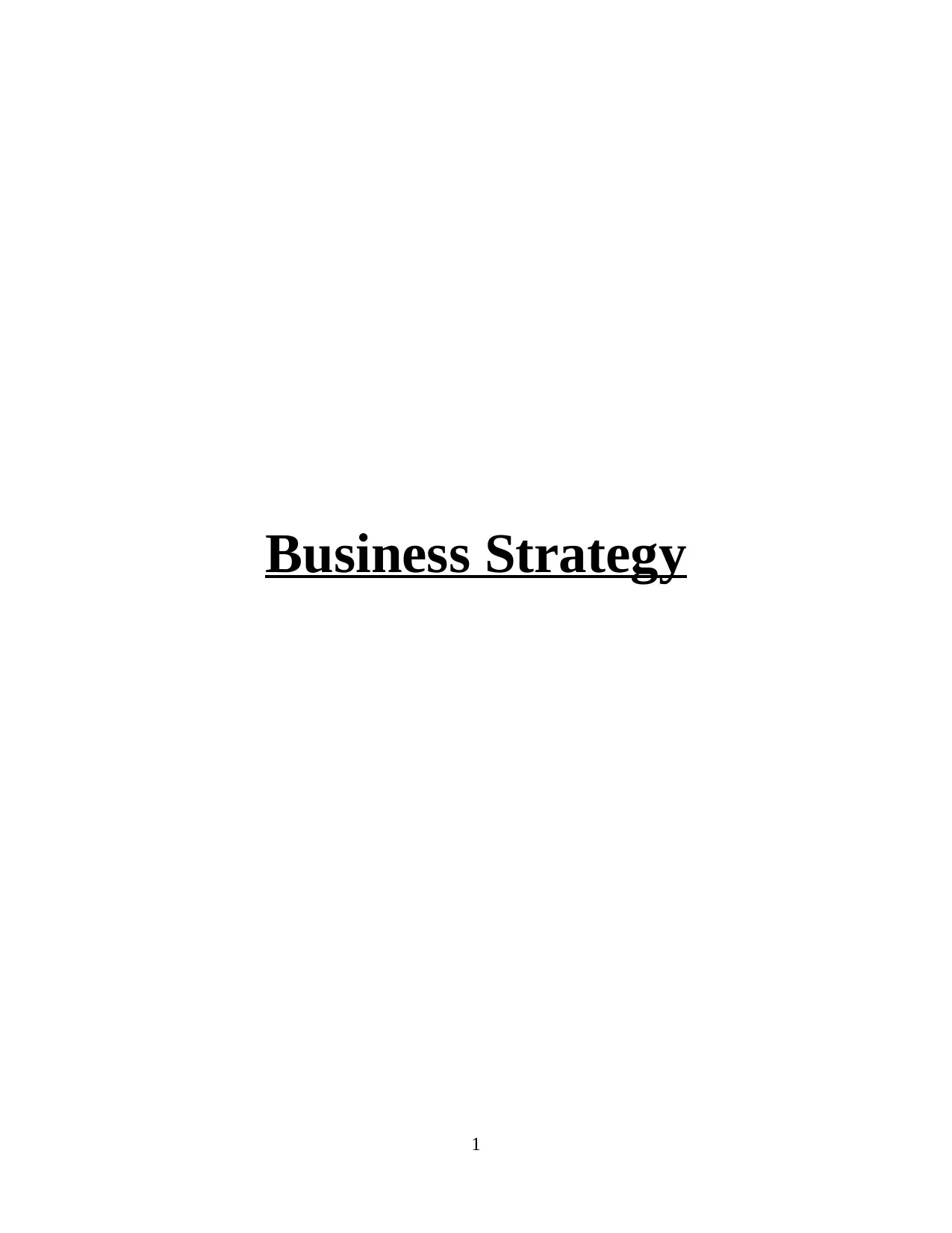
Business Strategy
1
1
Paraphrase This Document
Need a fresh take? Get an instant paraphrase of this document with our AI Paraphraser
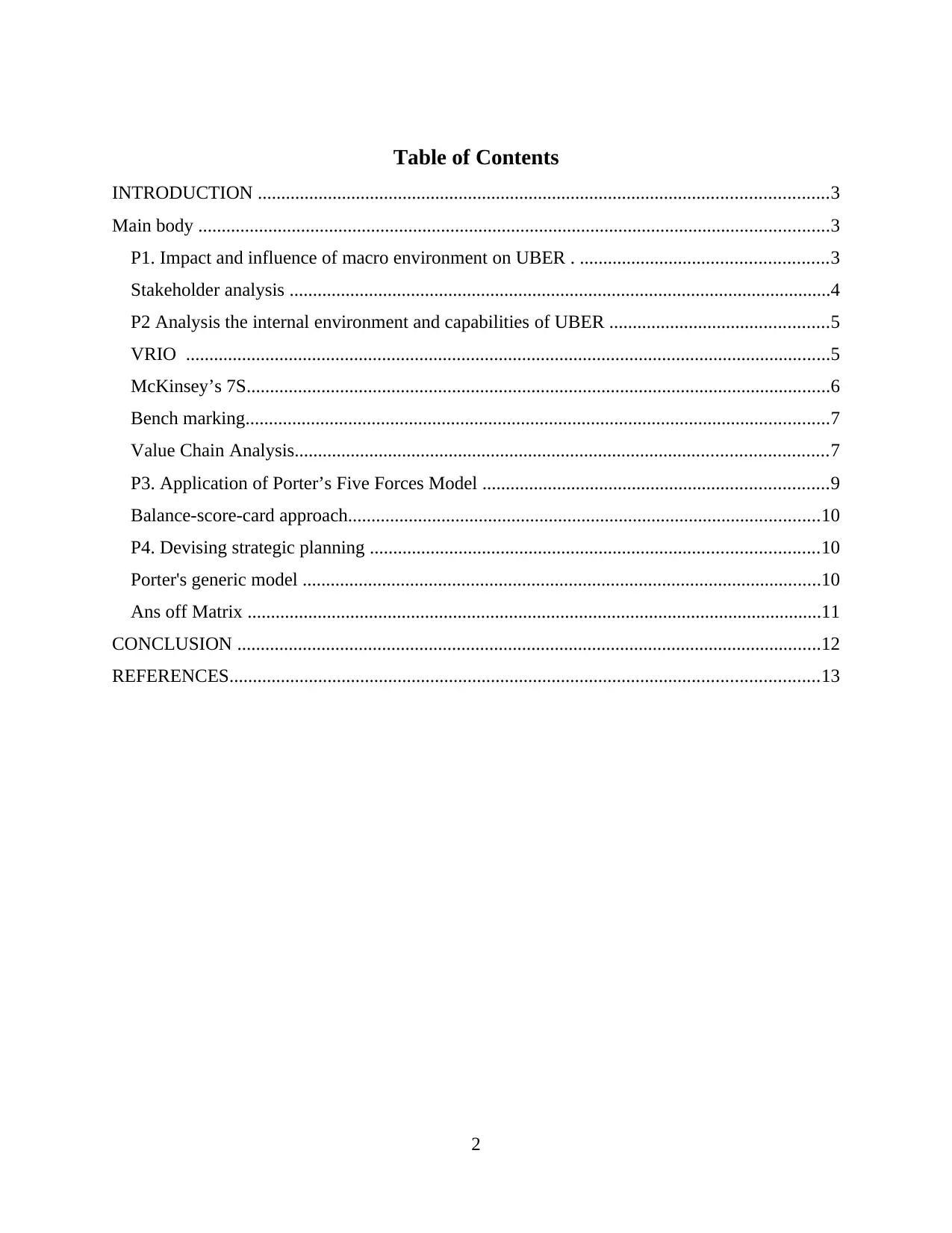
Table of Contents
INTRODUCTION ..........................................................................................................................3
Main body .......................................................................................................................................3
P1. Impact and influence of macro environment on UBER . .....................................................3
Stakeholder analysis ....................................................................................................................4
P2 Analysis the internal environment and capabilities of UBER ...............................................5
VRIO ..........................................................................................................................................5
McKinsey’s 7S.............................................................................................................................6
Bench marking.............................................................................................................................7
Value Chain Analysis..................................................................................................................7
P3. Application of Porter’s Five Forces Model ..........................................................................9
Balance-score-card approach.....................................................................................................10
P4. Devising strategic planning ................................................................................................10
Porter's generic model ...............................................................................................................10
Ans off Matrix ...........................................................................................................................11
CONCLUSION .............................................................................................................................12
REFERENCES..............................................................................................................................13
2
INTRODUCTION ..........................................................................................................................3
Main body .......................................................................................................................................3
P1. Impact and influence of macro environment on UBER . .....................................................3
Stakeholder analysis ....................................................................................................................4
P2 Analysis the internal environment and capabilities of UBER ...............................................5
VRIO ..........................................................................................................................................5
McKinsey’s 7S.............................................................................................................................6
Bench marking.............................................................................................................................7
Value Chain Analysis..................................................................................................................7
P3. Application of Porter’s Five Forces Model ..........................................................................9
Balance-score-card approach.....................................................................................................10
P4. Devising strategic planning ................................................................................................10
Porter's generic model ...............................................................................................................10
Ans off Matrix ...........................................................................................................................11
CONCLUSION .............................................................................................................................12
REFERENCES..............................................................................................................................13
2
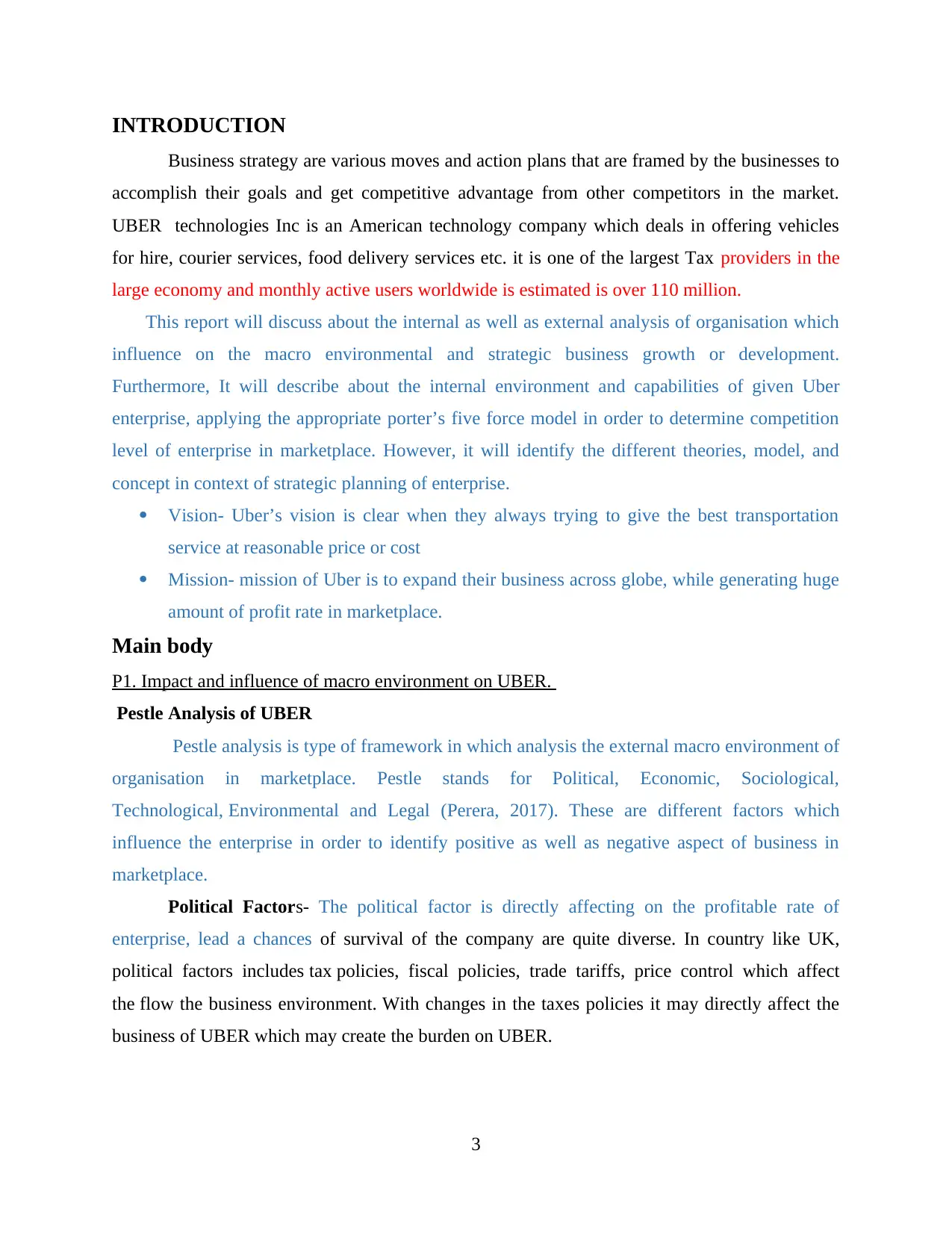
INTRODUCTION
Business strategy are various moves and action plans that are framed by the businesses to
accomplish their goals and get competitive advantage from other competitors in the market.
UBER technologies Inc is an American technology company which deals in offering vehicles
for hire, courier services, food delivery services etc. it is one of the largest Tax providers in the
large economy and monthly active users worldwide is estimated is over 110 million.
This report will discuss about the internal as well as external analysis of organisation which
influence on the macro environmental and strategic business growth or development.
Furthermore, It will describe about the internal environment and capabilities of given Uber
enterprise, applying the appropriate porter’s five force model in order to determine competition
level of enterprise in marketplace. However, it will identify the different theories, model, and
concept in context of strategic planning of enterprise.
Vision- Uber’s vision is clear when they always trying to give the best transportation
service at reasonable price or cost
Mission- mission of Uber is to expand their business across globe, while generating huge
amount of profit rate in marketplace.
Main body
P1. Impact and influence of macro environment on UBER.
Pestle Analysis of UBER
Pestle analysis is type of framework in which analysis the external macro environment of
organisation in marketplace. Pestle stands for Political, Economic, Sociological,
Technological, Environmental and Legal (Perera, 2017). These are different factors which
influence the enterprise in order to identify positive as well as negative aspect of business in
marketplace.
Political Factors- The political factor is directly affecting on the profitable rate of
enterprise, lead a chances of survival of the company are quite diverse. In country like UK,
political factors includes tax policies, fiscal policies, trade tariffs, price control which affect
the flow the business environment. With changes in the taxes policies it may directly affect the
business of UBER which may create the burden on UBER.
3
Business strategy are various moves and action plans that are framed by the businesses to
accomplish their goals and get competitive advantage from other competitors in the market.
UBER technologies Inc is an American technology company which deals in offering vehicles
for hire, courier services, food delivery services etc. it is one of the largest Tax providers in the
large economy and monthly active users worldwide is estimated is over 110 million.
This report will discuss about the internal as well as external analysis of organisation which
influence on the macro environmental and strategic business growth or development.
Furthermore, It will describe about the internal environment and capabilities of given Uber
enterprise, applying the appropriate porter’s five force model in order to determine competition
level of enterprise in marketplace. However, it will identify the different theories, model, and
concept in context of strategic planning of enterprise.
Vision- Uber’s vision is clear when they always trying to give the best transportation
service at reasonable price or cost
Mission- mission of Uber is to expand their business across globe, while generating huge
amount of profit rate in marketplace.
Main body
P1. Impact and influence of macro environment on UBER.
Pestle Analysis of UBER
Pestle analysis is type of framework in which analysis the external macro environment of
organisation in marketplace. Pestle stands for Political, Economic, Sociological,
Technological, Environmental and Legal (Perera, 2017). These are different factors which
influence the enterprise in order to identify positive as well as negative aspect of business in
marketplace.
Political Factors- The political factor is directly affecting on the profitable rate of
enterprise, lead a chances of survival of the company are quite diverse. In country like UK,
political factors includes tax policies, fiscal policies, trade tariffs, price control which affect
the flow the business environment. With changes in the taxes policies it may directly affect the
business of UBER which may create the burden on UBER.
3
⊘ This is a preview!⊘
Do you want full access?
Subscribe today to unlock all pages.

Trusted by 1+ million students worldwide
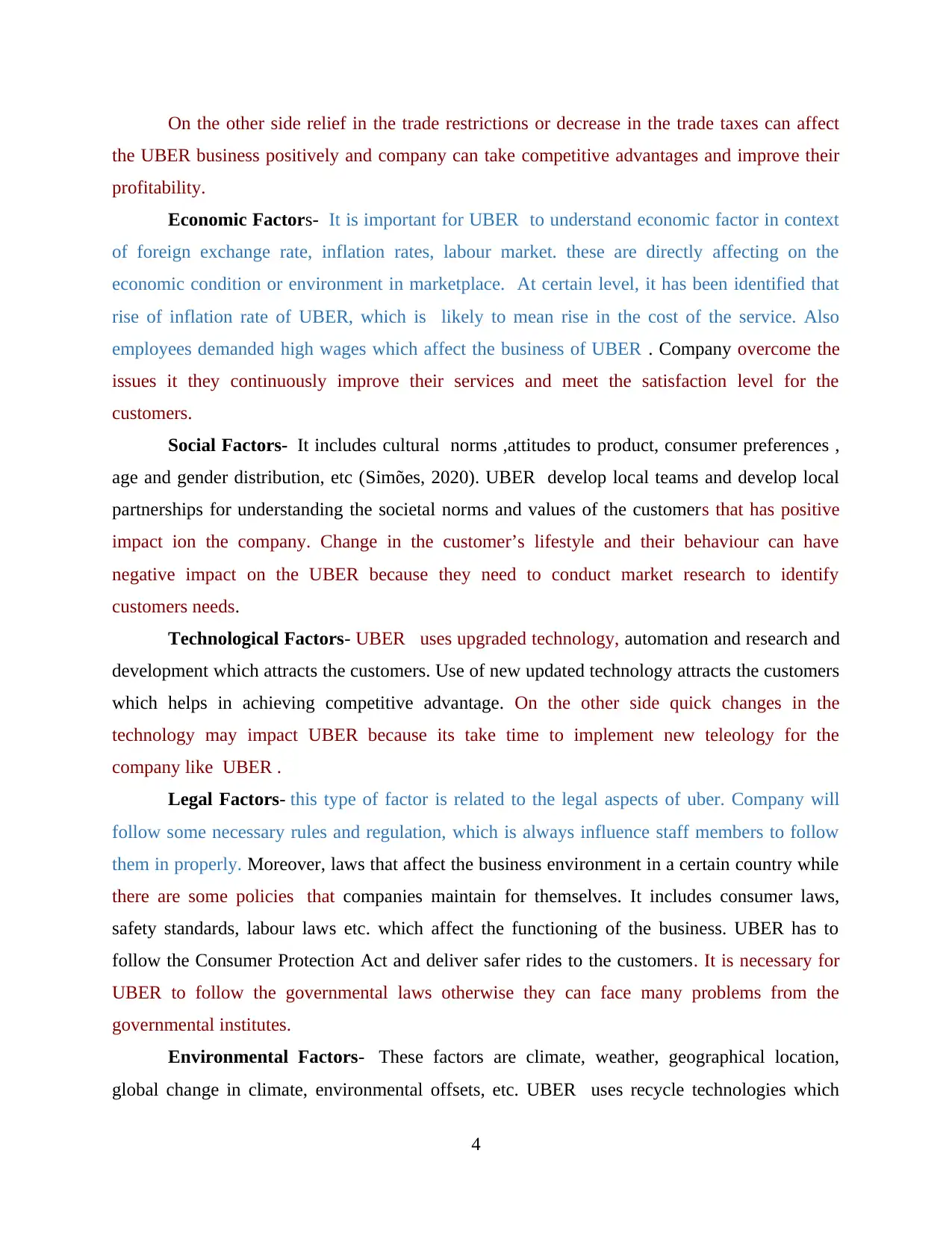
On the other side relief in the trade restrictions or decrease in the trade taxes can affect
the UBER business positively and company can take competitive advantages and improve their
profitability.
Economic Factors- It is important for UBER to understand economic factor in context
of foreign exchange rate, inflation rates, labour market. these are directly affecting on the
economic condition or environment in marketplace. At certain level, it has been identified that
rise of inflation rate of UBER, which is likely to mean rise in the cost of the service. Also
employees demanded high wages which affect the business of UBER . Company overcome the
issues it they continuously improve their services and meet the satisfaction level for the
customers.
Social Factors- It includes cultural norms ,attitudes to product, consumer preferences ,
age and gender distribution, etc (Simões, 2020). UBER develop local teams and develop local
partnerships for understanding the societal norms and values of the customers that has positive
impact ion the company. Change in the customer’s lifestyle and their behaviour can have
negative impact on the UBER because they need to conduct market research to identify
customers needs.
Technological Factors- UBER uses upgraded technology, automation and research and
development which attracts the customers. Use of new updated technology attracts the customers
which helps in achieving competitive advantage. On the other side quick changes in the
technology may impact UBER because its take time to implement new teleology for the
company like UBER .
Legal Factors- this type of factor is related to the legal aspects of uber. Company will
follow some necessary rules and regulation, which is always influence staff members to follow
them in properly. Moreover, laws that affect the business environment in a certain country while
there are some policies that companies maintain for themselves. It includes consumer laws,
safety standards, labour laws etc. which affect the functioning of the business. UBER has to
follow the Consumer Protection Act and deliver safer rides to the customers. It is necessary for
UBER to follow the governmental laws otherwise they can face many problems from the
governmental institutes.
Environmental Factors- These factors are climate, weather, geographical location,
global change in climate, environmental offsets, etc. UBER uses recycle technologies which
4
the UBER business positively and company can take competitive advantages and improve their
profitability.
Economic Factors- It is important for UBER to understand economic factor in context
of foreign exchange rate, inflation rates, labour market. these are directly affecting on the
economic condition or environment in marketplace. At certain level, it has been identified that
rise of inflation rate of UBER, which is likely to mean rise in the cost of the service. Also
employees demanded high wages which affect the business of UBER . Company overcome the
issues it they continuously improve their services and meet the satisfaction level for the
customers.
Social Factors- It includes cultural norms ,attitudes to product, consumer preferences ,
age and gender distribution, etc (Simões, 2020). UBER develop local teams and develop local
partnerships for understanding the societal norms and values of the customers that has positive
impact ion the company. Change in the customer’s lifestyle and their behaviour can have
negative impact on the UBER because they need to conduct market research to identify
customers needs.
Technological Factors- UBER uses upgraded technology, automation and research and
development which attracts the customers. Use of new updated technology attracts the customers
which helps in achieving competitive advantage. On the other side quick changes in the
technology may impact UBER because its take time to implement new teleology for the
company like UBER .
Legal Factors- this type of factor is related to the legal aspects of uber. Company will
follow some necessary rules and regulation, which is always influence staff members to follow
them in properly. Moreover, laws that affect the business environment in a certain country while
there are some policies that companies maintain for themselves. It includes consumer laws,
safety standards, labour laws etc. which affect the functioning of the business. UBER has to
follow the Consumer Protection Act and deliver safer rides to the customers. It is necessary for
UBER to follow the governmental laws otherwise they can face many problems from the
governmental institutes.
Environmental Factors- These factors are climate, weather, geographical location,
global change in climate, environmental offsets, etc. UBER uses recycle technologies which
4
Paraphrase This Document
Need a fresh take? Get an instant paraphrase of this document with our AI Paraphraser
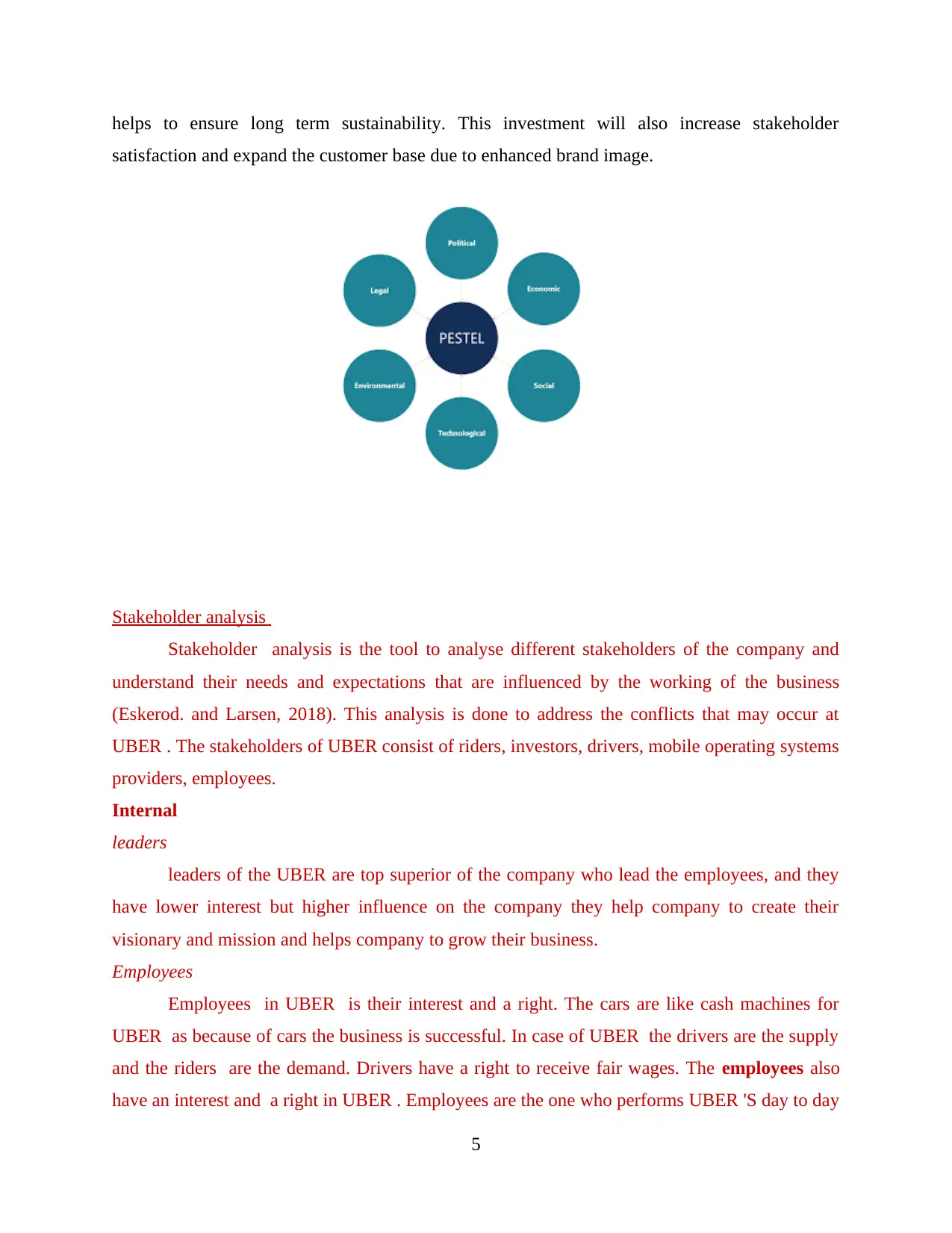
helps to ensure long term sustainability. This investment will also increase stakeholder
satisfaction and expand the customer base due to enhanced brand image.
Stakeholder analysis
Stakeholder analysis is the tool to analyse different stakeholders of the company and
understand their needs and expectations that are influenced by the working of the business
(Eskerod. and Larsen, 2018). This analysis is done to address the conflicts that may occur at
UBER . The stakeholders of UBER consist of riders, investors, drivers, mobile operating systems
providers, employees.
Internal
leaders
leaders of the UBER are top superior of the company who lead the employees, and they
have lower interest but higher influence on the company they help company to create their
visionary and mission and helps company to grow their business.
Employees
Employees in UBER is their interest and a right. The cars are like cash machines for
UBER as because of cars the business is successful. In case of UBER the drivers are the supply
and the riders are the demand. Drivers have a right to receive fair wages. The employees also
have an interest and a right in UBER . Employees are the one who performs UBER 'S day to day
5
satisfaction and expand the customer base due to enhanced brand image.
Stakeholder analysis
Stakeholder analysis is the tool to analyse different stakeholders of the company and
understand their needs and expectations that are influenced by the working of the business
(Eskerod. and Larsen, 2018). This analysis is done to address the conflicts that may occur at
UBER . The stakeholders of UBER consist of riders, investors, drivers, mobile operating systems
providers, employees.
Internal
leaders
leaders of the UBER are top superior of the company who lead the employees, and they
have lower interest but higher influence on the company they help company to create their
visionary and mission and helps company to grow their business.
Employees
Employees in UBER is their interest and a right. The cars are like cash machines for
UBER as because of cars the business is successful. In case of UBER the drivers are the supply
and the riders are the demand. Drivers have a right to receive fair wages. The employees also
have an interest and a right in UBER . Employees are the one who performs UBER 'S day to day
5
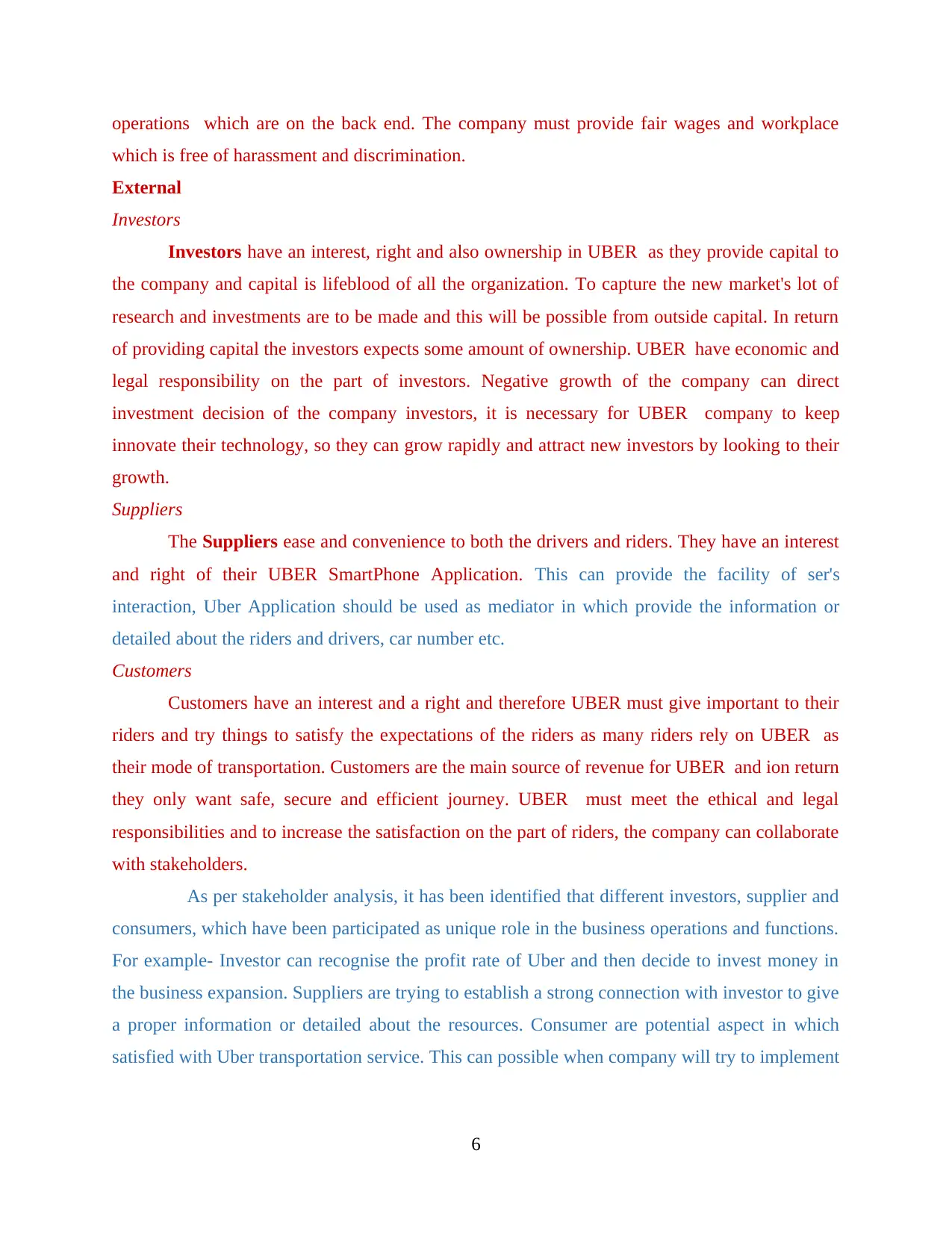
operations which are on the back end. The company must provide fair wages and workplace
which is free of harassment and discrimination.
External
Investors
Investors have an interest, right and also ownership in UBER as they provide capital to
the company and capital is lifeblood of all the organization. To capture the new market's lot of
research and investments are to be made and this will be possible from outside capital. In return
of providing capital the investors expects some amount of ownership. UBER have economic and
legal responsibility on the part of investors. Negative growth of the company can direct
investment decision of the company investors, it is necessary for UBER company to keep
innovate their technology, so they can grow rapidly and attract new investors by looking to their
growth.
Suppliers
The Suppliers ease and convenience to both the drivers and riders. They have an interest
and right of their UBER SmartPhone Application. This can provide the facility of ser's
interaction, Uber Application should be used as mediator in which provide the information or
detailed about the riders and drivers, car number etc.
Customers
Customers have an interest and a right and therefore UBER must give important to their
riders and try things to satisfy the expectations of the riders as many riders rely on UBER as
their mode of transportation. Customers are the main source of revenue for UBER and ion return
they only want safe, secure and efficient journey. UBER must meet the ethical and legal
responsibilities and to increase the satisfaction on the part of riders, the company can collaborate
with stakeholders.
As per stakeholder analysis, it has been identified that different investors, supplier and
consumers, which have been participated as unique role in the business operations and functions.
For example- Investor can recognise the profit rate of Uber and then decide to invest money in
the business expansion. Suppliers are trying to establish a strong connection with investor to give
a proper information or detailed about the resources. Consumer are potential aspect in which
satisfied with Uber transportation service. This can possible when company will try to implement
6
which is free of harassment and discrimination.
External
Investors
Investors have an interest, right and also ownership in UBER as they provide capital to
the company and capital is lifeblood of all the organization. To capture the new market's lot of
research and investments are to be made and this will be possible from outside capital. In return
of providing capital the investors expects some amount of ownership. UBER have economic and
legal responsibility on the part of investors. Negative growth of the company can direct
investment decision of the company investors, it is necessary for UBER company to keep
innovate their technology, so they can grow rapidly and attract new investors by looking to their
growth.
Suppliers
The Suppliers ease and convenience to both the drivers and riders. They have an interest
and right of their UBER SmartPhone Application. This can provide the facility of ser's
interaction, Uber Application should be used as mediator in which provide the information or
detailed about the riders and drivers, car number etc.
Customers
Customers have an interest and a right and therefore UBER must give important to their
riders and try things to satisfy the expectations of the riders as many riders rely on UBER as
their mode of transportation. Customers are the main source of revenue for UBER and ion return
they only want safe, secure and efficient journey. UBER must meet the ethical and legal
responsibilities and to increase the satisfaction on the part of riders, the company can collaborate
with stakeholders.
As per stakeholder analysis, it has been identified that different investors, supplier and
consumers, which have been participated as unique role in the business operations and functions.
For example- Investor can recognise the profit rate of Uber and then decide to invest money in
the business expansion. Suppliers are trying to establish a strong connection with investor to give
a proper information or detailed about the resources. Consumer are potential aspect in which
satisfied with Uber transportation service. This can possible when company will try to implement
6
⊘ This is a preview!⊘
Do you want full access?
Subscribe today to unlock all pages.

Trusted by 1+ million students worldwide
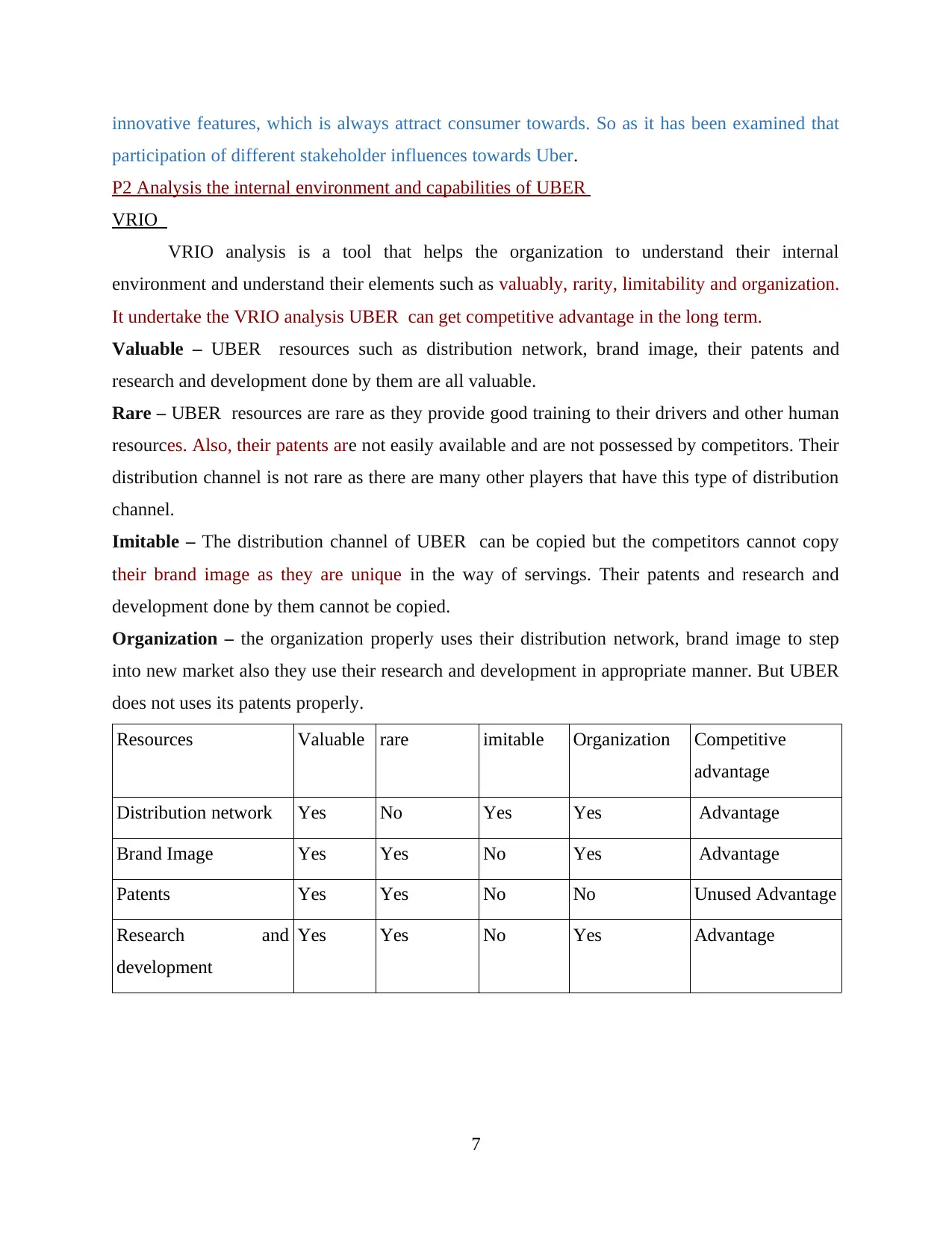
innovative features, which is always attract consumer towards. So as it has been examined that
participation of different stakeholder influences towards Uber.
P2 Analysis the internal environment and capabilities of UBER
VRIO
VRIO analysis is a tool that helps the organization to understand their internal
environment and understand their elements such as valuably, rarity, limitability and organization.
It undertake the VRIO analysis UBER can get competitive advantage in the long term.
Valuable – UBER resources such as distribution network, brand image, their patents and
research and development done by them are all valuable.
Rare – UBER resources are rare as they provide good training to their drivers and other human
resources. Also, their patents are not easily available and are not possessed by competitors. Their
distribution channel is not rare as there are many other players that have this type of distribution
channel.
Imitable – The distribution channel of UBER can be copied but the competitors cannot copy
their brand image as they are unique in the way of servings. Their patents and research and
development done by them cannot be copied.
Organization – the organization properly uses their distribution network, brand image to step
into new market also they use their research and development in appropriate manner. But UBER
does not uses its patents properly.
Resources Valuable rare imitable Organization Competitive
advantage
Distribution network Yes No Yes Yes Advantage
Brand Image Yes Yes No Yes Advantage
Patents Yes Yes No No Unused Advantage
Research and
development
Yes Yes No Yes Advantage
7
participation of different stakeholder influences towards Uber.
P2 Analysis the internal environment and capabilities of UBER
VRIO
VRIO analysis is a tool that helps the organization to understand their internal
environment and understand their elements such as valuably, rarity, limitability and organization.
It undertake the VRIO analysis UBER can get competitive advantage in the long term.
Valuable – UBER resources such as distribution network, brand image, their patents and
research and development done by them are all valuable.
Rare – UBER resources are rare as they provide good training to their drivers and other human
resources. Also, their patents are not easily available and are not possessed by competitors. Their
distribution channel is not rare as there are many other players that have this type of distribution
channel.
Imitable – The distribution channel of UBER can be copied but the competitors cannot copy
their brand image as they are unique in the way of servings. Their patents and research and
development done by them cannot be copied.
Organization – the organization properly uses their distribution network, brand image to step
into new market also they use their research and development in appropriate manner. But UBER
does not uses its patents properly.
Resources Valuable rare imitable Organization Competitive
advantage
Distribution network Yes No Yes Yes Advantage
Brand Image Yes Yes No Yes Advantage
Patents Yes Yes No No Unused Advantage
Research and
development
Yes Yes No Yes Advantage
7
Paraphrase This Document
Need a fresh take? Get an instant paraphrase of this document with our AI Paraphraser
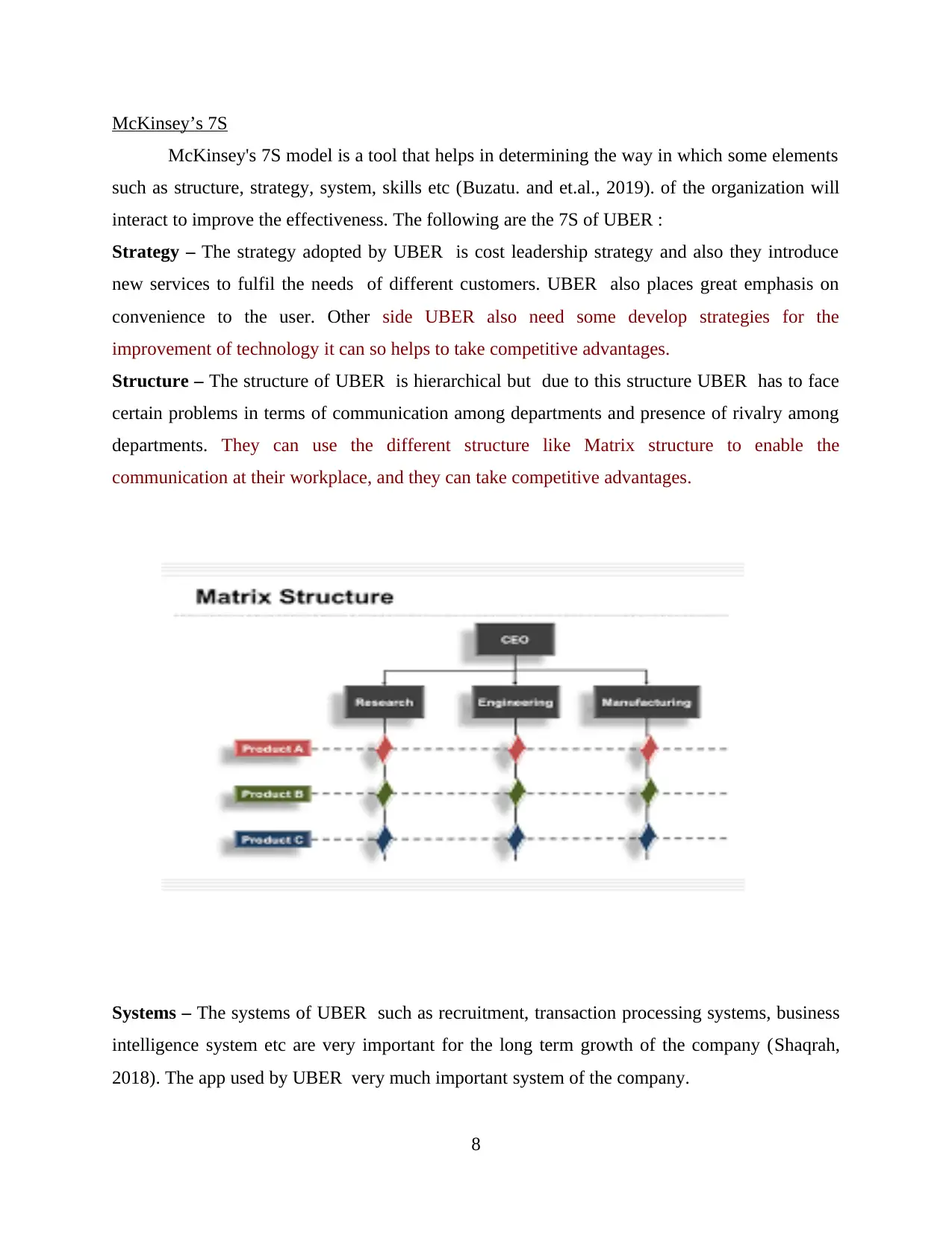
McKinsey’s 7S
McKinsey's 7S model is a tool that helps in determining the way in which some elements
such as structure, strategy, system, skills etc (Buzatu. and et.al., 2019). of the organization will
interact to improve the effectiveness. The following are the 7S of UBER :
Strategy – The strategy adopted by UBER is cost leadership strategy and also they introduce
new services to fulfil the needs of different customers. UBER also places great emphasis on
convenience to the user. Other side UBER also need some develop strategies for the
improvement of technology it can so helps to take competitive advantages.
Structure – The structure of UBER is hierarchical but due to this structure UBER has to face
certain problems in terms of communication among departments and presence of rivalry among
departments. They can use the different structure like Matrix structure to enable the
communication at their workplace, and they can take competitive advantages.
Systems – The systems of UBER such as recruitment, transaction processing systems, business
intelligence system etc are very important for the long term growth of the company (Shaqrah,
2018). The app used by UBER very much important system of the company.
8
McKinsey's 7S model is a tool that helps in determining the way in which some elements
such as structure, strategy, system, skills etc (Buzatu. and et.al., 2019). of the organization will
interact to improve the effectiveness. The following are the 7S of UBER :
Strategy – The strategy adopted by UBER is cost leadership strategy and also they introduce
new services to fulfil the needs of different customers. UBER also places great emphasis on
convenience to the user. Other side UBER also need some develop strategies for the
improvement of technology it can so helps to take competitive advantages.
Structure – The structure of UBER is hierarchical but due to this structure UBER has to face
certain problems in terms of communication among departments and presence of rivalry among
departments. They can use the different structure like Matrix structure to enable the
communication at their workplace, and they can take competitive advantages.
Systems – The systems of UBER such as recruitment, transaction processing systems, business
intelligence system etc are very important for the long term growth of the company (Shaqrah,
2018). The app used by UBER very much important system of the company.
8
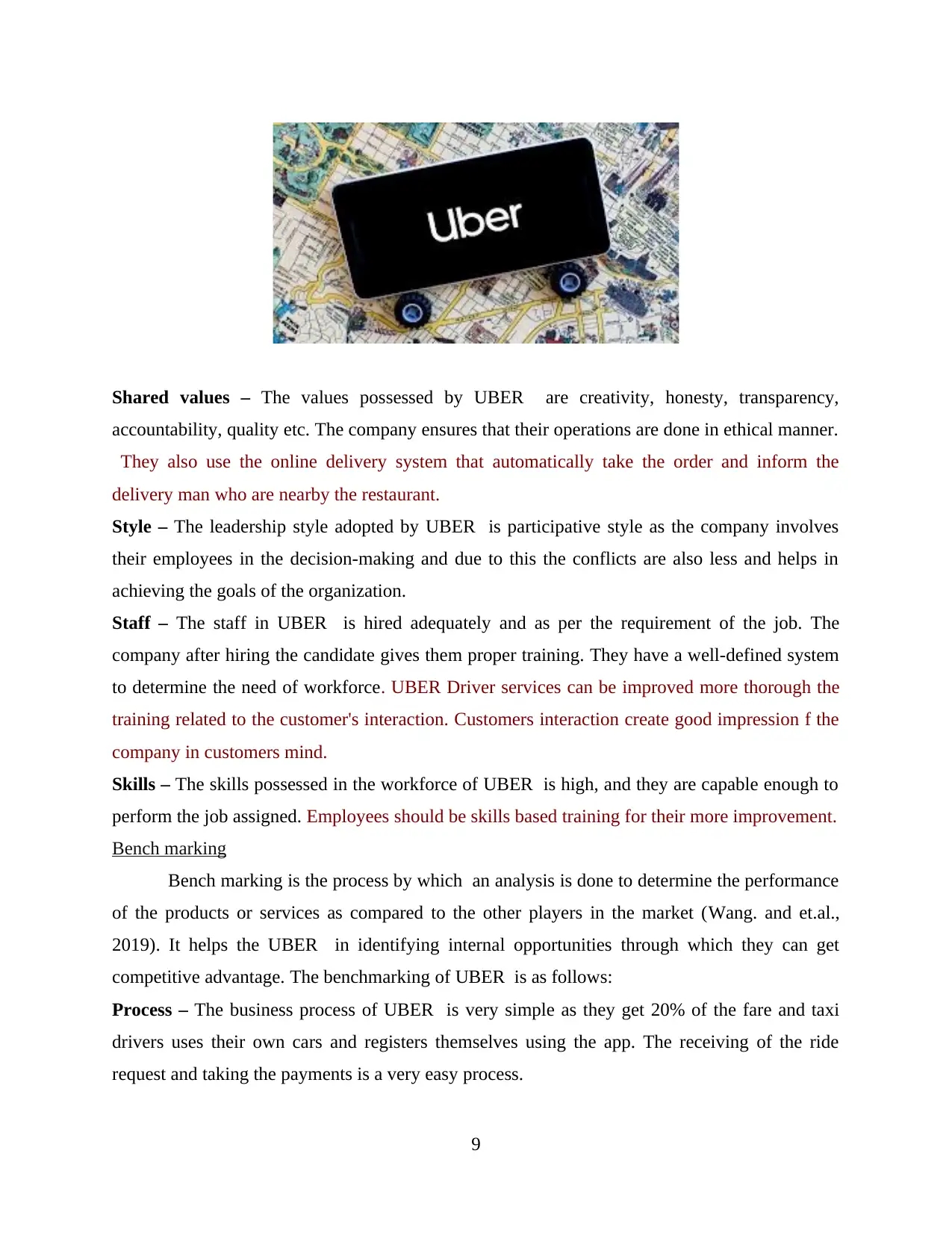
Shared values – The values possessed by UBER are creativity, honesty, transparency,
accountability, quality etc. The company ensures that their operations are done in ethical manner.
They also use the online delivery system that automatically take the order and inform the
delivery man who are nearby the restaurant.
Style – The leadership style adopted by UBER is participative style as the company involves
their employees in the decision-making and due to this the conflicts are also less and helps in
achieving the goals of the organization.
Staff – The staff in UBER is hired adequately and as per the requirement of the job. The
company after hiring the candidate gives them proper training. They have a well-defined system
to determine the need of workforce. UBER Driver services can be improved more thorough the
training related to the customer's interaction. Customers interaction create good impression f the
company in customers mind.
Skills – The skills possessed in the workforce of UBER is high, and they are capable enough to
perform the job assigned. Employees should be skills based training for their more improvement.
Bench marking
Bench marking is the process by which an analysis is done to determine the performance
of the products or services as compared to the other players in the market (Wang. and et.al.,
2019). It helps the UBER in identifying internal opportunities through which they can get
competitive advantage. The benchmarking of UBER is as follows:
Process – The business process of UBER is very simple as they get 20% of the fare and taxi
drivers uses their own cars and registers themselves using the app. The receiving of the ride
request and taking the payments is a very easy process.
9
accountability, quality etc. The company ensures that their operations are done in ethical manner.
They also use the online delivery system that automatically take the order and inform the
delivery man who are nearby the restaurant.
Style – The leadership style adopted by UBER is participative style as the company involves
their employees in the decision-making and due to this the conflicts are also less and helps in
achieving the goals of the organization.
Staff – The staff in UBER is hired adequately and as per the requirement of the job. The
company after hiring the candidate gives them proper training. They have a well-defined system
to determine the need of workforce. UBER Driver services can be improved more thorough the
training related to the customer's interaction. Customers interaction create good impression f the
company in customers mind.
Skills – The skills possessed in the workforce of UBER is high, and they are capable enough to
perform the job assigned. Employees should be skills based training for their more improvement.
Bench marking
Bench marking is the process by which an analysis is done to determine the performance
of the products or services as compared to the other players in the market (Wang. and et.al.,
2019). It helps the UBER in identifying internal opportunities through which they can get
competitive advantage. The benchmarking of UBER is as follows:
Process – The business process of UBER is very simple as they get 20% of the fare and taxi
drivers uses their own cars and registers themselves using the app. The receiving of the ride
request and taking the payments is a very easy process.
9
⊘ This is a preview!⊘
Do you want full access?
Subscribe today to unlock all pages.

Trusted by 1+ million students worldwide
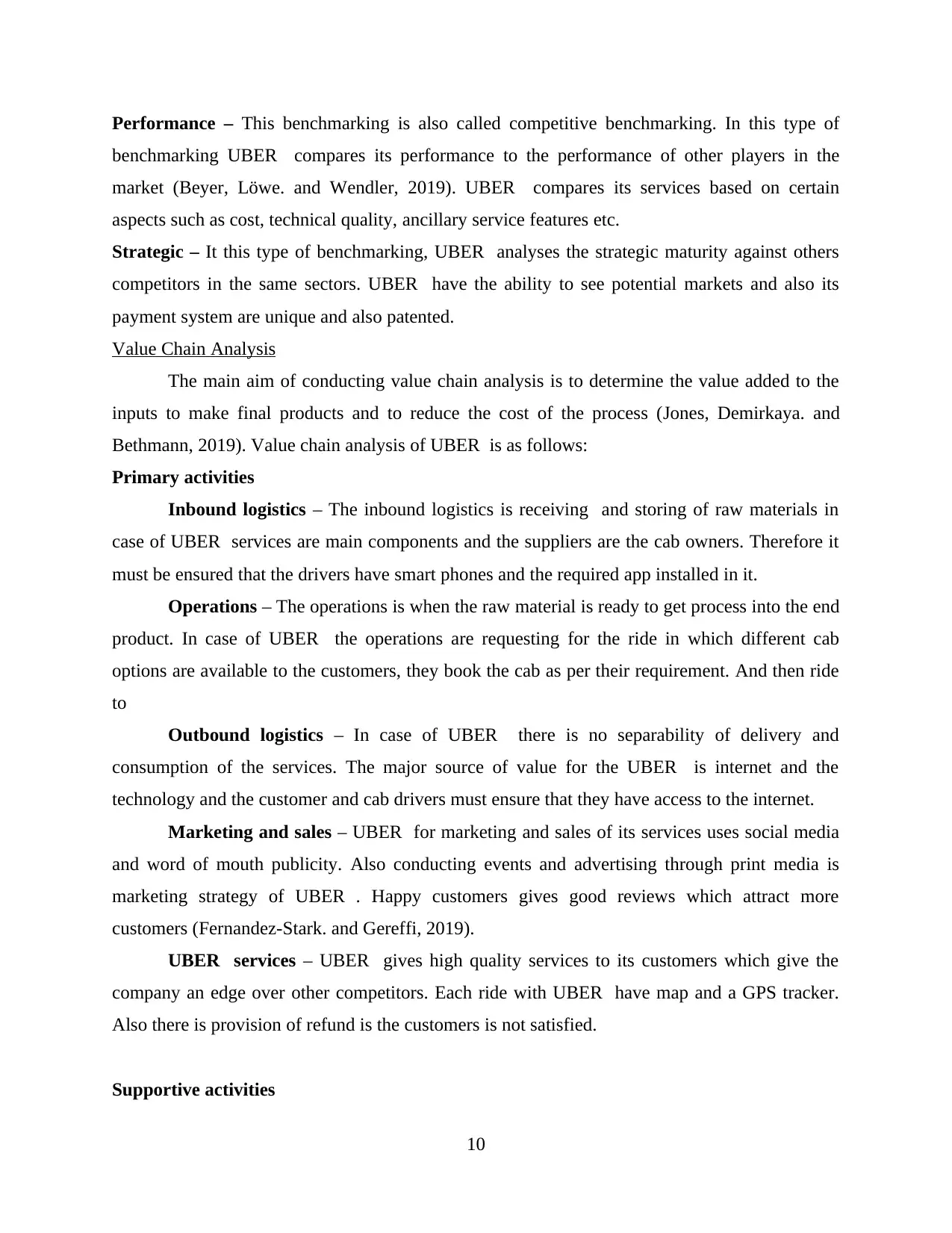
Performance – This benchmarking is also called competitive benchmarking. In this type of
benchmarking UBER compares its performance to the performance of other players in the
market (Beyer, Löwe. and Wendler, 2019). UBER compares its services based on certain
aspects such as cost, technical quality, ancillary service features etc.
Strategic – It this type of benchmarking, UBER analyses the strategic maturity against others
competitors in the same sectors. UBER have the ability to see potential markets and also its
payment system are unique and also patented.
Value Chain Analysis
The main aim of conducting value chain analysis is to determine the value added to the
inputs to make final products and to reduce the cost of the process (Jones, Demirkaya. and
Bethmann, 2019). Value chain analysis of UBER is as follows:
Primary activities
Inbound logistics – The inbound logistics is receiving and storing of raw materials in
case of UBER services are main components and the suppliers are the cab owners. Therefore it
must be ensured that the drivers have smart phones and the required app installed in it.
Operations – The operations is when the raw material is ready to get process into the end
product. In case of UBER the operations are requesting for the ride in which different cab
options are available to the customers, they book the cab as per their requirement. And then ride
to
Outbound logistics – In case of UBER there is no separability of delivery and
consumption of the services. The major source of value for the UBER is internet and the
technology and the customer and cab drivers must ensure that they have access to the internet.
Marketing and sales – UBER for marketing and sales of its services uses social media
and word of mouth publicity. Also conducting events and advertising through print media is
marketing strategy of UBER . Happy customers gives good reviews which attract more
customers (Fernandez-Stark. and Gereffi, 2019).
UBER services – UBER gives high quality services to its customers which give the
company an edge over other competitors. Each ride with UBER have map and a GPS tracker.
Also there is provision of refund is the customers is not satisfied.
Supportive activities
10
benchmarking UBER compares its performance to the performance of other players in the
market (Beyer, Löwe. and Wendler, 2019). UBER compares its services based on certain
aspects such as cost, technical quality, ancillary service features etc.
Strategic – It this type of benchmarking, UBER analyses the strategic maturity against others
competitors in the same sectors. UBER have the ability to see potential markets and also its
payment system are unique and also patented.
Value Chain Analysis
The main aim of conducting value chain analysis is to determine the value added to the
inputs to make final products and to reduce the cost of the process (Jones, Demirkaya. and
Bethmann, 2019). Value chain analysis of UBER is as follows:
Primary activities
Inbound logistics – The inbound logistics is receiving and storing of raw materials in
case of UBER services are main components and the suppliers are the cab owners. Therefore it
must be ensured that the drivers have smart phones and the required app installed in it.
Operations – The operations is when the raw material is ready to get process into the end
product. In case of UBER the operations are requesting for the ride in which different cab
options are available to the customers, they book the cab as per their requirement. And then ride
to
Outbound logistics – In case of UBER there is no separability of delivery and
consumption of the services. The major source of value for the UBER is internet and the
technology and the customer and cab drivers must ensure that they have access to the internet.
Marketing and sales – UBER for marketing and sales of its services uses social media
and word of mouth publicity. Also conducting events and advertising through print media is
marketing strategy of UBER . Happy customers gives good reviews which attract more
customers (Fernandez-Stark. and Gereffi, 2019).
UBER services – UBER gives high quality services to its customers which give the
company an edge over other competitors. Each ride with UBER have map and a GPS tracker.
Also there is provision of refund is the customers is not satisfied.
Supportive activities
10
Paraphrase This Document
Need a fresh take? Get an instant paraphrase of this document with our AI Paraphraser
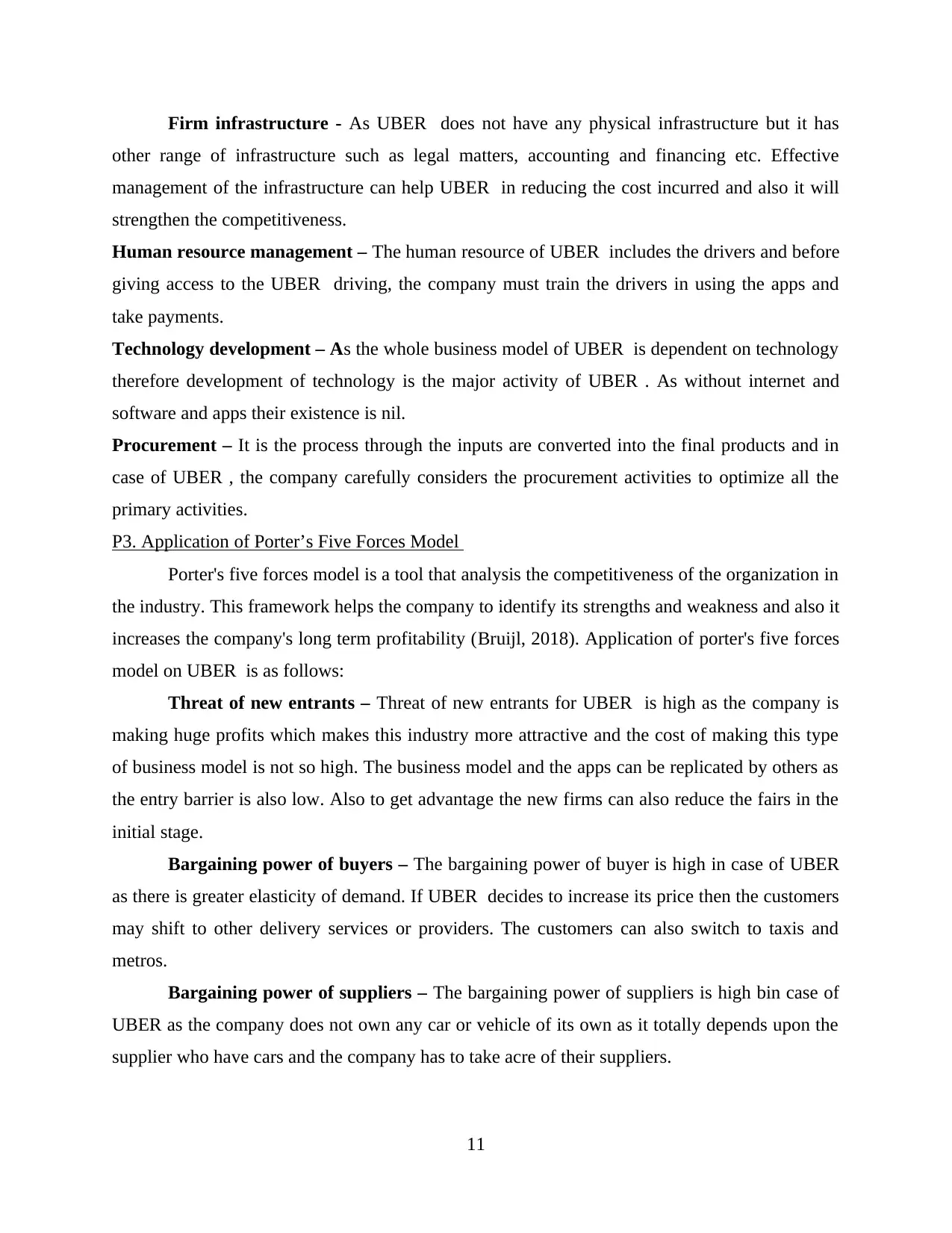
Firm infrastructure - As UBER does not have any physical infrastructure but it has
other range of infrastructure such as legal matters, accounting and financing etc. Effective
management of the infrastructure can help UBER in reducing the cost incurred and also it will
strengthen the competitiveness.
Human resource management – The human resource of UBER includes the drivers and before
giving access to the UBER driving, the company must train the drivers in using the apps and
take payments.
Technology development – As the whole business model of UBER is dependent on technology
therefore development of technology is the major activity of UBER . As without internet and
software and apps their existence is nil.
Procurement – It is the process through the inputs are converted into the final products and in
case of UBER , the company carefully considers the procurement activities to optimize all the
primary activities.
P3. Application of Porter’s Five Forces Model
Porter's five forces model is a tool that analysis the competitiveness of the organization in
the industry. This framework helps the company to identify its strengths and weakness and also it
increases the company's long term profitability (Bruijl, 2018). Application of porter's five forces
model on UBER is as follows:
Threat of new entrants – Threat of new entrants for UBER is high as the company is
making huge profits which makes this industry more attractive and the cost of making this type
of business model is not so high. The business model and the apps can be replicated by others as
the entry barrier is also low. Also to get advantage the new firms can also reduce the fairs in the
initial stage.
Bargaining power of buyers – The bargaining power of buyer is high in case of UBER
as there is greater elasticity of demand. If UBER decides to increase its price then the customers
may shift to other delivery services or providers. The customers can also switch to taxis and
metros.
Bargaining power of suppliers – The bargaining power of suppliers is high bin case of
UBER as the company does not own any car or vehicle of its own as it totally depends upon the
supplier who have cars and the company has to take acre of their suppliers.
11
other range of infrastructure such as legal matters, accounting and financing etc. Effective
management of the infrastructure can help UBER in reducing the cost incurred and also it will
strengthen the competitiveness.
Human resource management – The human resource of UBER includes the drivers and before
giving access to the UBER driving, the company must train the drivers in using the apps and
take payments.
Technology development – As the whole business model of UBER is dependent on technology
therefore development of technology is the major activity of UBER . As without internet and
software and apps their existence is nil.
Procurement – It is the process through the inputs are converted into the final products and in
case of UBER , the company carefully considers the procurement activities to optimize all the
primary activities.
P3. Application of Porter’s Five Forces Model
Porter's five forces model is a tool that analysis the competitiveness of the organization in
the industry. This framework helps the company to identify its strengths and weakness and also it
increases the company's long term profitability (Bruijl, 2018). Application of porter's five forces
model on UBER is as follows:
Threat of new entrants – Threat of new entrants for UBER is high as the company is
making huge profits which makes this industry more attractive and the cost of making this type
of business model is not so high. The business model and the apps can be replicated by others as
the entry barrier is also low. Also to get advantage the new firms can also reduce the fairs in the
initial stage.
Bargaining power of buyers – The bargaining power of buyer is high in case of UBER
as there is greater elasticity of demand. If UBER decides to increase its price then the customers
may shift to other delivery services or providers. The customers can also switch to taxis and
metros.
Bargaining power of suppliers – The bargaining power of suppliers is high bin case of
UBER as the company does not own any car or vehicle of its own as it totally depends upon the
supplier who have cars and the company has to take acre of their suppliers.
11
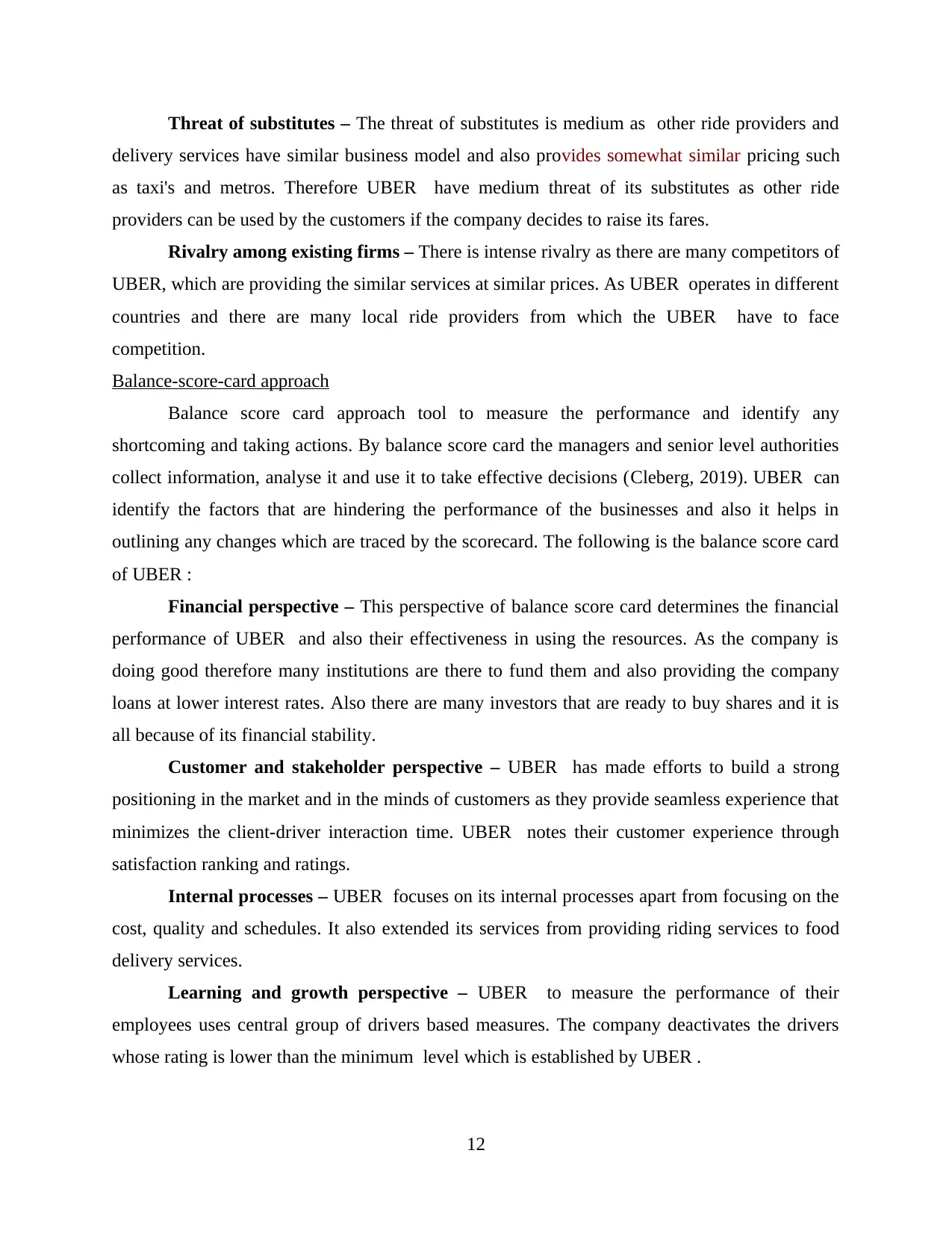
Threat of substitutes – The threat of substitutes is medium as other ride providers and
delivery services have similar business model and also provides somewhat similar pricing such
as taxi's and metros. Therefore UBER have medium threat of its substitutes as other ride
providers can be used by the customers if the company decides to raise its fares.
Rivalry among existing firms – There is intense rivalry as there are many competitors of
UBER, which are providing the similar services at similar prices. As UBER operates in different
countries and there are many local ride providers from which the UBER have to face
competition.
Balance-score-card approach
Balance score card approach tool to measure the performance and identify any
shortcoming and taking actions. By balance score card the managers and senior level authorities
collect information, analyse it and use it to take effective decisions (Cleberg, 2019). UBER can
identify the factors that are hindering the performance of the businesses and also it helps in
outlining any changes which are traced by the scorecard. The following is the balance score card
of UBER :
Financial perspective – This perspective of balance score card determines the financial
performance of UBER and also their effectiveness in using the resources. As the company is
doing good therefore many institutions are there to fund them and also providing the company
loans at lower interest rates. Also there are many investors that are ready to buy shares and it is
all because of its financial stability.
Customer and stakeholder perspective – UBER has made efforts to build a strong
positioning in the market and in the minds of customers as they provide seamless experience that
minimizes the client-driver interaction time. UBER notes their customer experience through
satisfaction ranking and ratings.
Internal processes – UBER focuses on its internal processes apart from focusing on the
cost, quality and schedules. It also extended its services from providing riding services to food
delivery services.
Learning and growth perspective – UBER to measure the performance of their
employees uses central group of drivers based measures. The company deactivates the drivers
whose rating is lower than the minimum level which is established by UBER .
12
delivery services have similar business model and also provides somewhat similar pricing such
as taxi's and metros. Therefore UBER have medium threat of its substitutes as other ride
providers can be used by the customers if the company decides to raise its fares.
Rivalry among existing firms – There is intense rivalry as there are many competitors of
UBER, which are providing the similar services at similar prices. As UBER operates in different
countries and there are many local ride providers from which the UBER have to face
competition.
Balance-score-card approach
Balance score card approach tool to measure the performance and identify any
shortcoming and taking actions. By balance score card the managers and senior level authorities
collect information, analyse it and use it to take effective decisions (Cleberg, 2019). UBER can
identify the factors that are hindering the performance of the businesses and also it helps in
outlining any changes which are traced by the scorecard. The following is the balance score card
of UBER :
Financial perspective – This perspective of balance score card determines the financial
performance of UBER and also their effectiveness in using the resources. As the company is
doing good therefore many institutions are there to fund them and also providing the company
loans at lower interest rates. Also there are many investors that are ready to buy shares and it is
all because of its financial stability.
Customer and stakeholder perspective – UBER has made efforts to build a strong
positioning in the market and in the minds of customers as they provide seamless experience that
minimizes the client-driver interaction time. UBER notes their customer experience through
satisfaction ranking and ratings.
Internal processes – UBER focuses on its internal processes apart from focusing on the
cost, quality and schedules. It also extended its services from providing riding services to food
delivery services.
Learning and growth perspective – UBER to measure the performance of their
employees uses central group of drivers based measures. The company deactivates the drivers
whose rating is lower than the minimum level which is established by UBER .
12
⊘ This is a preview!⊘
Do you want full access?
Subscribe today to unlock all pages.

Trusted by 1+ million students worldwide
1 out of 16
Related Documents
Your All-in-One AI-Powered Toolkit for Academic Success.
+13062052269
info@desklib.com
Available 24*7 on WhatsApp / Email
![[object Object]](/_next/static/media/star-bottom.7253800d.svg)
Unlock your academic potential
Copyright © 2020–2025 A2Z Services. All Rights Reserved. Developed and managed by ZUCOL.





